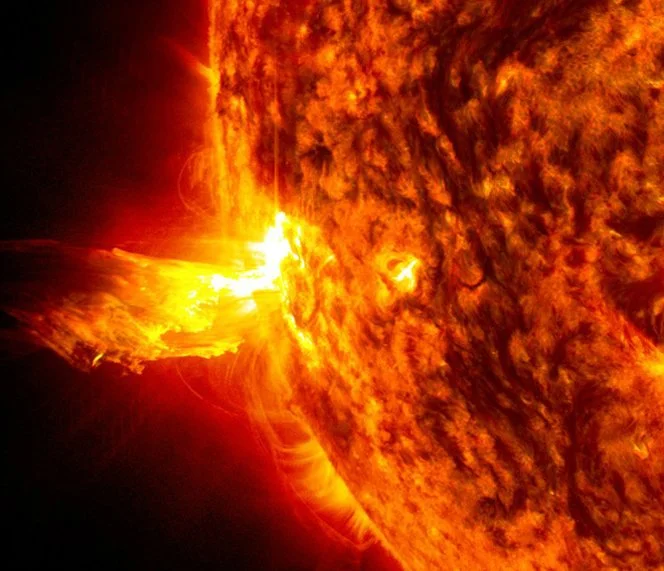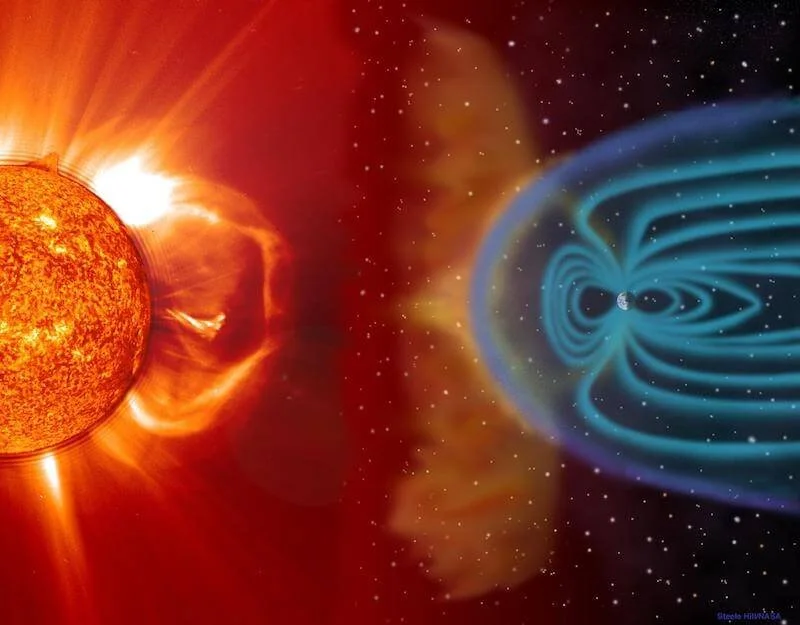Aurora Borealis and the Schwabe Cycle
Our Sun is a huge ball of electrically-charged hot gas. This charged gas moves, generating a powerful magnetic field. The Sun's magnetic field goes through a cycle, called the solar cycle.
Heinrich Schwabe, an astronomer from Germany, conducted observations of the Sun from 1826 to 1843 and determined that the Sun rotates on its axis once in 27 days. He also established that activity on the Sun increases and decreases over approximately an 11 year cycle. This theory was calculated on the occurrence of sunspots (dark areas caused by magnetic disturbances). Sunspots are cool areas that look like dark blemishes on the surface of the Sun. They form when magnetic field lines below the surface poke though the Sun's photosphere (a layer of the Sun's surface). A dedicated amateur scientist, he made a significant contribution to our understanding of the sun and its effect on our earth.
The Sun's activity cycle, called the "solar cycle" or Schwabe Cycle, goes from minimum to maximum and back to minimum, as sunspots are absent, increase over time, and then decrease. The period of rise from minimum phase (when sunspots may be absent for several weeks) to maximum phase (when 20 or more groups may be present at one time) takes an average of four years. The decrease from maximum back to minimum occurs over the following seven years, hence the eleven year cycle.
Schwabe also determined that the Sun's activity has terrestrial effects. The solar cycle causes variations in Earth's magnetic field. During the solar maximum there are numerous sunspots, solar flares (explosions on the surface of the Sun), and coronal mass ejections (charged particles thrown off the surface of the Sun). Energetic particles from these events, carried by the solar wind, affects our weather and cause disruption to communication, navigation, and power systems.
This image from June 20, 2013, at 11:15 p.m. EDT shows the bright light of a solar flare on the left side of the sun and an eruption of solar material shooting through the sun’s atmosphere, called a prominence eruption. Shortly thereafter, this same region of the sun sent a coronal mass ejection out into space. --- On June 20, 2013, at 11:24 p.m., the sun erupted with an Earth-directed coronal mass ejection or CME, a solar phenomenon that can send billions of tons of particles into space that can reach Earth one to three days later. These particles cannot travel through the atmosphere to harm humans on Earth, but they can affect electronic systems in satellites and on the ground. Experimental NASA research models, based on observations from NASA’s Solar Terrestrial Relations Observatory and ESA/NASA’s Solar and Heliospheric Observatory show that the CME left the sun at speeds of around 1350 miles per second, which is a fast speed for CMEs. Earth-directed CMEs can cause a space weather phenomenon called a geomagnetic storm, which occurs when they funnel energy into Earth's magnetic envelope, the magnetosphere, for an extended period of time. The CME’s magnetic fields peel back the outermost layers of Earth's fields changing their very shape. Magnetic storms can degrade communication signals and cause unexpected electrical surges in power grids. They also can cause aurora. Storms are rare during solar minimum, but as the sun’s activity ramps up every 11 years toward solar maximum – currently expected in 2024-2025 -- large storms occur several times per year. In the past, geomagnetic storms caused by CMEs of this strength and direction have usually been mild. Credit: NASA/Goddard/SDO NASA image use policy. NASA Goddard Space Flight Center enables NASA’s mission through four scientific endeavors: Earth Science, Heliophysics, Solar System Exploration, and Astrophysics. Goddard plays a leading role in NASA’s accomplishments by contributing compelling scientific knowledge to advance the Agency’s mission.
In this image, the blue lines represent the shield created by Earth’s magnetic field. Notice how the solar wind shapes the magnetic field.
Giant eruptions on the Sun, such as solar flares and coronal mass ejections, also increase during the solar cycle. These eruptions send powerful bursts of energy and material into space.
This activity can have effects on Earth. For example, eruptions can cause lights in the sky, called aurora, or impact radio communications. Extreme eruptions can even affect electricity grids on Earth.
Earth has an area of magnetic force activity, called a magnetic field. It is also surrounded by a jacket of gases, called an atmosphere. Our magnetic field and atmosphere act like a superhero’s shield, protecting us from the majority of the solar wind blast.
Most of the charged particles crash into Earth’s shield and flow around it. The particles squish and flatten the side of the magnetic field that faces the Sun. The other side of the magnetic field stretches into a long, trailing tail.
Sometimes charged particles sneak past Earth’s shield. When these particles hit the atmosphere, we are treated to glowing light shows known as auroras or Aurora Borealis.
Aurora Borealis from Pleasant Acres Reindeer Ranch. Photographer - Kenny Spann



